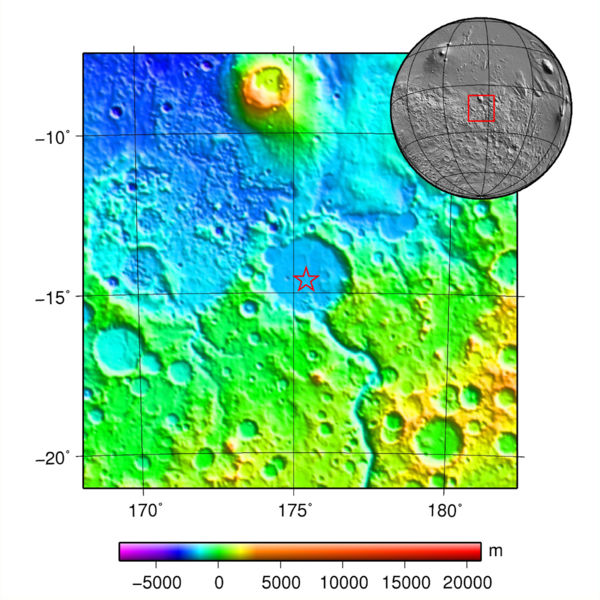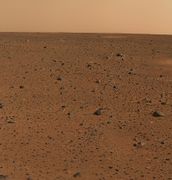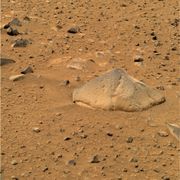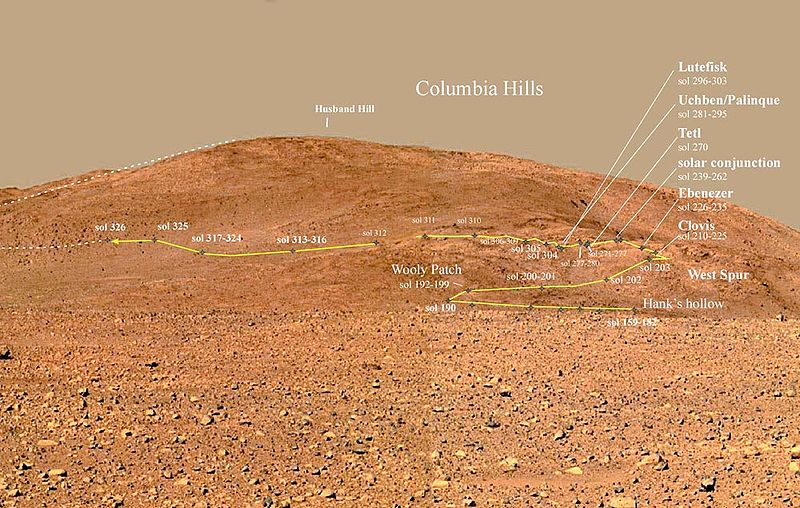Spirit
Spirit took off from Cape Canaveral on June 10, 2003, landed on Mars on January 4, 2004, and was finally declared done exploring Mars on May 25, 2011. Its last contact was March 22, 2010. That was quite a feat to last so long, as it was only designed to last 3 months. The landing site was 14.5684 S and 175.472636 E in the Aeolis quadrangle. [1]
Spirit’s landing site Part of Spirit’s solar panel is visible in the foreground.
Spirit’s landing site shown with a star.
Contents
Spacecraft
The Spirit and Opportunity Rovers were identical in construction. With a weight of 408 lbs. (185 kg), they are the size of a small car—1.5 meters tall, 2.3 meters wide, and 1.6 meters long.[2] [3] [4]
Mars Spirit Rover with parts labeled
Instruments
- Panoramic Camera (Pancam)
- Microscopic Imager (MI)
- Hazcams
- Navcams
- Miniature Thermal Emission Spectrometer (Mini-TES)
- Mössbauer Spectrometer (MB)
- Alpha Particle X-Ray Spectrometer (APXS)
- Rock Abrasion Tool (RAT)
- Magnet Array
- Calibration targets ( including a sundial)[5]
Findings
Many forms of evidence from Spirit’s instruments pointed to the past presence of water. Original minerals had been changed in ways that occur when water is present. Following are more details of how minerals found by Spirit indicate how water changed rocks. Spirit’s instruments found that rocks on the plains of Gusev are a type of basalt. They contain the minerals olivine, pyroxene, plagioclase, and magnetite, and resemble the volcanic basalt as they are fine-grained with irregular holes (geologists would say they have vesicles and vugs).[6] [7] Much of the soil on the plains came from the breakdown of nearby rocks. Some soils showed fairly high levels of nickel; probably from meteorites.[8] Analysis led scientists to believe that the rocks have been slightly altered by tiny amounts of water. Outside coatings and cracks inside the rocks suggest water deposited minerals (maybe bromine compounds). All the rocks contain a fine coating of dust and one or more harder kinds of substance. One type can be brushed off, while another needed to be removed by the Rock Abrasion Tool (RAT).[9]
There are a variety of rocks in the Columbia Hills (Mars), some of which have been altered by water, but by very little water. The dust in Gusev Crater was determined to be the same as dust all around the planet. All the dust was magnetic. Moreover, Spirit found the magnetism was caused by the mineral magnetite-- especially magnetite that contained the element titanium. Since one of the magnets was able to completely divert all the dust, it was concluded that all Martian dust is magnetic.[10] The spectra of the dust was similar to spectra of bright, low thermal inertia regions like Arabia and Tharsis that have been detected by orbiting satellites. A thin layer of dust, maybe less than one millimeter thick, covers all surfaces. Besides being magnetic, something in it contains a small amount of chemically bound water.[11] [12]
Plains
Examinations with Spirits’ instruments of rocks on the plains show they contain the minerals pyroxene, olivine, plagioclase, and magnetite. The amounts and types of minerals found lead to a classification of primitive basalts—also called picritic basalts. They are comparable to ancient terrestrial rocks called basaltic komatiites. Rocks of the plains also resemble the basaltic shergottites, meteorites which came from Mars. [13] Plain’s rocks have been very slightly altered, probably by thin films of water that made them softer. Water also created veins of light colored material that may be bromine compounds, as well as coatings or rinds.[14] [15] Coatings on the rocks may have occurred when rocks were buried and interacted with thin films of water and dust. One sign that they were altered was that it was easier to grind these rocks compared to the same types of rocks found on Earth. The first rock that Spirit studied was Adirondack. It turned out to be typical of the other rocks on the plains.
Columbia Hills
Wide view from Bonneville Crater Hills on right hills nicknamed the "Columbia Hills” where Spirit eventually drove to.
Husband Hill with path taken by Spirit
Scientists found a variety of rock types in the Columbia Hills, and they placed them into six different categories. The six are: Clovis, Wishbone, Peace, Watchtower, Backstay, and Independence. They are named after a prominent rock in each group. Their chemical compositions, as measured by APXS, are significantly different from each other.[16] Most importantly, all of the rocks in Columbia Hills show various degrees of alteration due to aqueous fluids.[17] They are enriched in the elements phosphorus, sulfur, chlorine, and bromine—all of which can be carried around in water solutions. The Columbia Hills’ rocks contain basaltic glass, along with varying amounts of olivine and sulfates.[18] [19] The olivine abundance varies inversely with the amount of sulfates. This is exactly what is expected because water destroys olivine but helps to produce sulfates. Acid fog is believed to have changed some of the Watchtower rocks. This was especially noticeable in a 200 meter long section of Cumberland Ridge and the Husband Hill summit. Certain locations became more amorphous and less crystalline. Acidic water vapor from volcanoes dissolved some minerals forming a gel. When water evaporated, cement formed and produced small bumps. This same process has been observed in the lab when basalt rocks are exposed to sulfuric and hydrochloric acids.[20] [21] [22] The Clovis group is especially interesting because the Mössbauer spectrometer(MB) detected goethite in it.[23] Goethite forms only in the presence of water, so its discovery is the first direct evidence of past water in the Columbia Hills's rocks. In addition, the MB spectra of rocks and outcrops displayed a strong decline in olivine presence, [24] although the rocks probably once contained much olivine. Olivine breaks down in the presence of water; therefore, water must have been present to reduce the amount of Olivine.[25] Sulfate was found, and it needs water to be produced. Wishstone contained a great deal of plagioclase, some olivine, and anhydrate (a sulfate). Peace rocks showed sulfur and strong evidence for bound water; hence, hydrated sulfates are suspected. Watchtower class rocks lack olivine, consequently they may have been altered by water. The Independence class showed some signs of clay (perhaps montmorillonite--a member of the smectite group). Anytime we find clay we know that water most have been around for a while. One type of soil, called Paso Robles, from the Columbia Hills, may be an evaporate deposit since it contains large amounts of sulfur, phosphorus, calcium, and iron.[26] Also, MB found that much of the iron in Paso Robles soil was of the oxidized, Fe+++ form, which would happen if water had been present.[27] Towards the middle of the six-year mission (a mission that was supposed to last only 90 days), large amounts of pure silica were discovered in the soil. The silica could have come from the interaction of soil with acid vapors produced by volcanic activity in the presence of water or from water in a hot spring environment.[28]
After Spirit stopped working scientists studied old data from the Miniature Thermal Emission Spectrometer, or Mini-TES and confirmed the presence of large amounts of carbonate-rich rocks, which means that regions of the planet may have once harbored water. As the Martian atmosphere contains mostly carbon dioxide, one would expect it to be changed into carbonates if water was available. Earth’s large limestone layers were made in this manner. The carbonates of Mars were discovered in an outcrop of rocks called "Comanche."[29] [30]
In summary, Spirit found evidence of slight weathering on the plains of Gusev, but no evidence that a lake was there. However, in the Columbia Hills there was clear evidence for a moderate amount of aqueous weathering. The evidence included sulfates and the minerals goethite and carbonates which only form in the presence of water. It is believed that Gusev crater may have held a lake long ago, but it has since been covered by igneous materials. All the dust contains a magnetic component which was identified as magnetite with some titanium. Furthermore, the thin coating of dust that covers everything on Mars is the same in all parts of Mars.
References
- ↑ https://en.wikipedia.org/wiki/Spirit_(rover)
- ↑ https://mars.jpl.nasa.gov/mer/mission/spacecraft.html
- ↑ http://science.answers.com/Q/What_is_the_size_of_Mars_Spirit_rover
- ↑ https://mars.jpl.nasa.gov/mer/newsroom/merlandings.pdf
- ↑ https://mars.jpl.nasa.gov/mer/mission/spacecraft_surface_instru.html
- ↑ McSween, etal. 2004. "Basaltic Rocks Analyzed by the Spirit Rover in Gusev Crater". Science : 305. 842–845
- ↑ Arvidson R. E.; et al. (2004). "Localization and Physical Properties Experiments Conducted by Spirit at Gusev Crater". Science. 305 (5685): 821–824.
- ↑ Gelbert R.; et al. (2006). "The Alpha Particle X-ray Spectrometer (APXS): results from Gusev crater and calibration report". J. Geophys. Res. Planets. 111.
- ↑ Christensen P (August 2004). "Initial Results from the Mini-TES Experiment in Gusev Crater from the Spirit Rover". Science. 305 (5685): 837–842.
- ↑ Bertelsen, P., et al. 2004. "Magnetic Properties on the Mars Exploration Rover Spirit at Gusev Crater". Science: 305. 827–829
- ↑ Bell, J (ed.) The Martian Surface. 2008. Cambridge University Press.
- ↑ Gelbert, R. et al. "Chemistry of Rocks and Soils in Gusev Crater from the Alpha Particle X-ray Spectrometer". Science: 305. 829-305
- ↑ McSween, etal. 2004. "Basaltic Rocks Analyzed by the Spirit Rover in Gusev Crater". Science : 305. 842–845
- ↑ Arvidson R. E.; et al. (2004). "Localization and Physical Properties Experiments Conducted by Spirit at Gusev Crater". Science. 305 (5685): 821–824.
- ↑ McSween, etal. 2004. "Basaltic Rocks Analyzed by the Spirit Rover in Gusev Crater". Science : 305. 842–845
- ↑ Squyres, S., et al. 2006 Rocks of the Columbia Hills. J. Geophys. Res. Planets. 111
- ↑ Ming,D., et al. 2006 Geochemical and mineralogical indicators for aqueous processes in the Columbia Hills of Gusev crater, Mars. J. Geophys: Res.111
- ↑ Schroder, C., et al. 2005. European Geosciences Union, General Assembly, Geophysical Research abstr., Vol. 7, 10254, 2005
- ↑ Christensen, P. 2005. Mineral Composition and Abundance of the Rocks and Soils at Gusev and Meridiani from the Mars Exploration Rover Mini-TES Instruments AGU Joint Assembly, 23–27 May 2005 http://www.agu.org/meetings/sm05/waissm05.html
- ↑ http://spaceref.com/mars/signs-of-acid-fog-found-on-mars.html
- ↑ https://gsa.confex.com/gsa/2015AM/webprogram/Paper266774.html
- ↑ COLE, Shoshanna B., et al. 2015. IN-SITU EVIDENCE FOR ALTERATION BY ACID FOG ON HUSBAND HILL, GUSEV CRATER, MARS. 2015 GSA Annual Meeting in Baltimore, Maryland, USA (1–4 November 2015) Paper No. 94-10
- ↑ Klingelhofer, G., et al. 2005. Lunar Planet. Sci. XXXVI abstr. 2349
- ↑ Schroder, C., et al. (2005) European Geosciences Union, General Assembly, Geophysical Research abstr., Vol. 7, 10254, 2005
- ↑ Morris,S., et al. Mossbauer mineralogy of rock, soil, and dust at Gusev crater, Mars: Spirit’s journal through weakly altered olivine basalt on the plains and pervasively altered basalt in the Columbia Hills. J. Geophys. Res.: 111
- ↑ Ming,D., et al. 2006 Geochemical and mineralogical indicators for aqueous processes in the Columbia Hills of Gusev crater, Mars. J. Geophys. Res.111
- ↑ Bell, J (ed.) The Martian Surface. 2008. Cambridge University Press. ISBN 978-0-521-86698-9
- ↑ https://www.nasa.gov/mission_pages/mer/mer-20070521.html
- ↑ https://www.sciencedaily.com/releases/2010/06/100603140959.htm
- ↑ Morris, Richard V.; Ruff, Steven W.; Gellert, Ralf; Ming, Douglas W.; Arvidson, Raymond E.; Clark, Benton C.; Golden, D. C.; Siebach, Kirsten; Klingelhöfer, Göstar; Schröder, Christian; Fleischer, Iris; Yen, Albert S.; Squyres, Steven W. (2010). "Identification of Carbonate-Rich Outcrops on Mars by the Spirit Rover". Science. 329 (5990): 421–4.
See Also
Recommended reading
- Spirit (rover) From Wikipedia, the free encyclopedia
- Mars Exploration Rover Landings Press Kit
- wikipedia.Aeolis_quadrangle
External links
- NASA | Mars Atmosphere Loss: Sputtering
- How we landed on Mars with NASA Spirit
- NASA's Spirit Rover Completes Mission on Mars [720p]
- Spirit Rover - 3 years on Mars
- Highlights from landing day of Mars rover Spirit
- “WELCOME TO MARS” (documentary)
This article has no or virtually no content. You can help Marspedia by adding something to it.
|

















